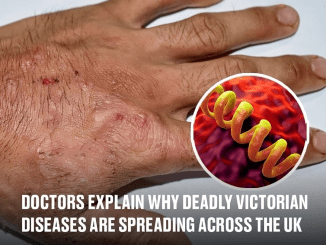In an alarming discovery, scientists have found something unsettling in human blood that could have far-reaching health implications. For the first time, researchers detected tiny plastic particles circulating in the bloodstream, raising serious concerns about their impact on long-term health. According to recent studies, these particles are present in nearly 80% of the people tested, with the potential to travel throughout the body and lodge in vital organs. With the rapid increase in plastic production and pollution, this discovery calls for urgent action and further investigation.

Let’s dive into what scientists have uncovered about these plastic particles, the potential health risks they pose, and why experts believe this issue is more pressing than ever.
The Rise of Microplastics: How They Enter Our Bloodstream
Plastic waste has become one of the most pervasive environmental pollutants. From the summit of Mount Everest to the depths of the ocean, traces of plastic are everywhere. These pollutants break down into tiny particles, known as microplastics, which find their way into our bodies through various pathways.
Research has shown that microplastics can be ingested through food and water, inhaled from the air, and even absorbed through the skin. They’ve been detected in the feces of both adults and babies, indicating that we are continuously exposed to these tiny plastic fragments. Given this widespread exposure, scientists suspected it was only a matter of time before microplastics would be found in our bloodstream.
In a recent study led by Professor Dick Vethaak, an ecotoxicologist at Vrije Universiteit Amsterdam, blood samples from 22 healthy participants were analyzed. Shockingly, 17 of these samples contained detectable levels of plastic particles. These findings suggest that microplastics are not only ingested but can enter our bloodstream and circulate throughout the body, potentially reaching our organs.
Types of Plastic Found in Human Blood
In the study, researchers found different types of plastic particles in the blood samples:
- PET Plastic: Present in half of the samples, PET is widely used in drink bottles and food packaging. It’s one of the most common types of plastic in everyday products.
- Polystyrene: Detected in a third of the blood samples, polystyrene is commonly used for packaging and disposable containers. Its brittle nature allows it to break down easily into microplastic particles.
- Polyethylene: Found in a quarter of the samples, polyethylene is the material from which plastic bags are made. Given the high volume of single-use bags, this plastic type is one of the major contributors to plastic pollution.
These findings show just how deeply plastic has permeated our environment and entered our bodies. While the quantities of plastic particles varied among the blood samples, the widespread presence of these materials underscores the urgency of understanding their impact on human health.
How Do Microplastics Affect Our Health?
The health effects of microplastics in the bloodstream are not yet fully understood, but initial research has raised significant concerns. In laboratory studies, plastic particles have been shown to cause cellular damage, including inflammation and oxidative stress. These conditions can lead to various health issues, including weakened immune response, hormonal disruptions, and, potentially, an increased risk of diseases.

Professor Vethaak and his team have warned that while this study provides a groundbreaking insight into the presence of plastic in human blood, more extensive research is urgently needed to determine the long-term effects. There are several unanswered questions, such as:
- Are these particles able to pass through the blood-brain barrier? If microplastics can reach the brain, they could potentially interfere with neurological functions and contribute to diseases like Alzheimer’s.
- Do microplastics accumulate in certain organs? Understanding whether these particles are flushed out or build up in the liver, kidneys, or lungs is crucial for assessing their impact on human health.
- Are they linked to cancer? A recent review co-authored by Professor Vethaak concluded that there is a pressing need to examine whether microplastics play a role in cellular changes that lead to cancer.
Why Babies and Young Children Are Especially Vulnerable
An even more concerning finding is that babies and young children may be at a higher risk of exposure to microplastics. Previous studies have shown that microplastic levels in infants are up to ten times higher than those in adults. One reason is the widespread use of plastic feeding bottles, which release millions of microplastic particles with each use. Additionally, children are more susceptible to chemical and particle exposure because their bodies are still developing.

Given these factors, the presence of plastic particles in the bloodstream of young children raises questions about potential developmental impacts. Professor Vethaak expressed particular concern, noting that “babies and young children are more vulnerable to chemical and particle exposure,” a troubling reality that underscores the urgency of further research in this area.
The Role of Plastic Pollution in Worsening the Health Crisis
Plastic pollution has long been recognized as an environmental crisis, but this new research indicates that it could also become a public health emergency. The exponential growth of plastic production has created a situation where these materials are now omnipresent in our ecosystem. The world produces over 300 million tons of plastic every year, much of which ends up in landfills or the ocean, breaking down into microplastics that enter the food chain and, ultimately, our bodies.
The COVID-19 pandemic exacerbated this problem, as single-use plastics surged with the increased use of personal protective equipment, takeout containers, and disposable packaging. As these plastics degrade, they contribute to an ever-growing amount of microplastic pollution in the environment, raising the stakes for human health.

Next Steps: What Needs to Be Done
Given the growing evidence of microplastics in the human body, scientists are calling for immediate action on multiple fronts:
- Increase Funding for Research: There is an urgent need for comprehensive studies on how microplastics impact human health. From examining their effects on cellular processes to assessing their role in diseases, research must be prioritized to understand the full scope of this issue.
- Strengthen Regulations on Plastic Production: Governments and industries need to implement stricter regulations to curb plastic production and minimize waste. Policies that promote recycling and reduce single-use plastics are essential for slowing the spread of plastic pollution.
- Raise Public Awareness: Educating the public about the dangers of plastic pollution is crucial for encouraging lifestyle changes that can reduce plastic use. By making informed choices, individuals can help decrease demand for single-use plastics, reducing the overall amount of plastic waste.
Conclusion: Confronting the Plastic Crisis
The discovery of plastic particles in human blood is a wake-up call that should not be ignored. It highlights the urgent need to confront the plastic crisis not only for the sake of the environment but for our own health. As scientists continue to investigate the effects of microplastics on the human body, one thing is clear: we must take action now to address this growing threat.
Whether through supporting research, advocating for stricter regulations, or making conscious choices to reduce plastic use, each of us can contribute to a healthier, safer world. The stakes are high, and the time to act is now.


